
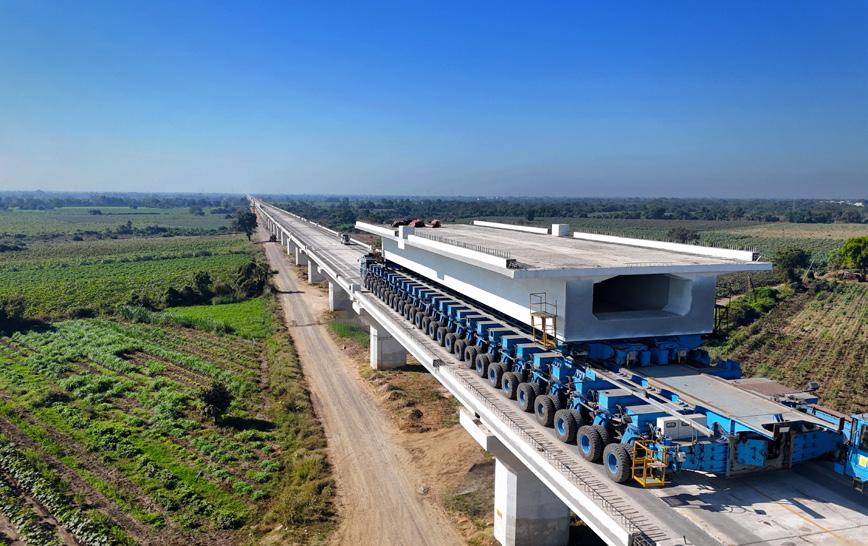
The Girder Transporter in action
Perhaps, one of the toughest challenges (and there are many!) facing Task Force Leader, G Vinod and his various teams at the Mumbai-Ahmedabad High Speed Rail (MAHSR) project is the sheer magnitude and pace of construction, hitherto unheard of or seen in the Indian construction industry. “Of course, we know what to do and how to do it because of the cumulative experience we possess in our teams, but our endeavour is to seek ways to do it faster and more efficiently,” he says. “Very often, with no precedents, we have to think afresh which is what you might call innovation,” he flashes a quick smile. While various teams from both Heavy Civil Infrastructure & Transportation ICs are straining every muscle and sinew to keep up with the tall asking rate, Vinod will certainly agree that technology has been their great ally, the veritable wind beneath their wings.
Cranking up the pace of precast activity
The project team must deal with some 7 million cubic meters of concrete; 40 m long girders each weighing approximately 1,100 tons each requiring 390 cm of concrete. Casting and erecting precast structures involve various complex activities that are understandably time consuming, demanding a synchronous interplay of man, material and machine. The process includes reinforcement-cutting & bending, rebar cage making; casting that involves mould preparation, concrete pouring, finishing; to final erection – preparation of girder launching, erection & alignment. A lot to do but the question was: How to achieve all this quicker?
“We realized that we first needed to know the time taken for each activity,” points out Rakesh Kumar Jha, Vice President & Project Director – MAHSR, Section 1. “To identify idle time, spot inefficiencies, analyse the interrelation of the various activities, and even the impact of seasonality on productivity, for the monsoons and labour migration patterns were leading to fluctuations in the availability of skilled workers, we developed an App to track the entire precasting activity and with the insights it threw up, we were better equipped to make informed decisions regarding project scheduling and resource allocation,” he highlights.
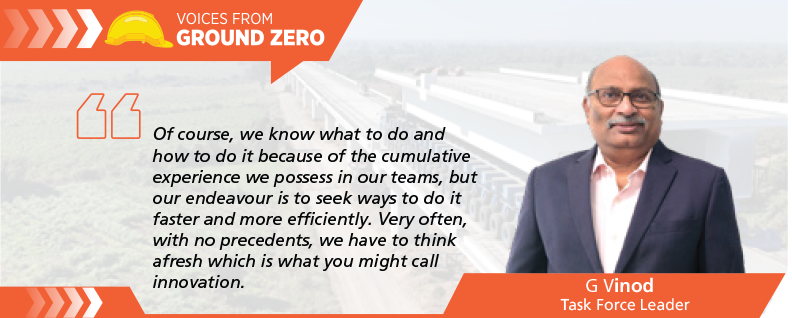
The App revealed interdependencies between man, material & machine for effective resource management and de-bottlenecking. By checking the duration of activities across different yards, the team arrived at a suitable and beneficial practice for reapplication across all the yards throughout the project. “Apart from identifying and propagating best practices, we can analyse processes span level, mould wise,” adds Rakesh.
With greater visibility, the App has immeasurably speeded up the process of casting & erecting 5,000+ spans, enhancing efficiency to the tune of 10-15%.

RRCM fast-tracking rebar cage fabrication
Leading with Robotics
Rebar cage fabrication has traditionally been a manual exercise with workers shaping, bending & tying the reinforcement bars (rebars) and therefore prone to inconsistent quality, slow rates of production and heavy dependence on skilled labour. The C4 team’s solution was the advanced Robotic Rebar Cage Manufacturing (RRCM) unit that with multiple robots can handle, position, feed, convey and weld rebars far more efficiently and quickly.
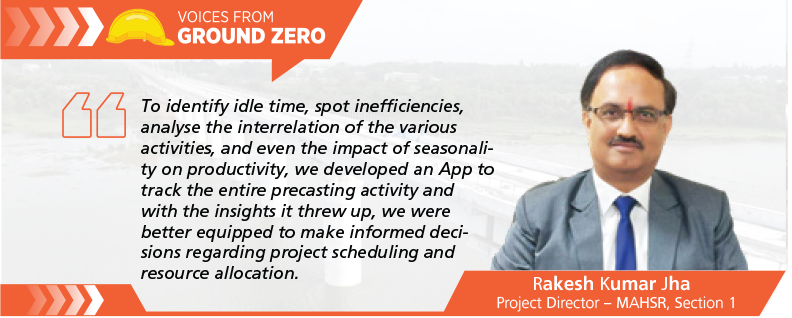
Robotic arms bend, cut, and tie rebars automatically, to ensure precise positioning according to the design specifications, reducing human intervention. Specialized machines weld and tie rebar intersections eliminating manual tying, reducing inconsistencies and enhancing the durability of the cages. Automated systems integrated with sensors and quality control mechanisms ensure that the rebar cages meet structural requirements, detecting alignment, spacing, and tie strength to uphold safety standards.
“The benefits of RRCM are several,” smiles a pleased T Kalaiyarasan, Senior Deputy General Manager (Civil), ticking them off on his fingers. “It is precise up to +- 1 mm, is significantly faster, is more efficient, cuts cost of labour, and wastage of raw material has been reduced by 99.99%.” He pauses and adds, “We enjoy advantages of accuracy, quality, safety, flexibility and adaptability too.”
The task can now be completed with just 2 workers as against 45 earlier, reducing manpower requirements from 6 to just 0.13 per MT. Eminently scalable, RRCM is waiting to be taken to projects across businesses to improve business efficiencies.
Building inhouse capabilities to reduce external dependence
Three vital elements that the MAHSR team produce are noise barriers and cable ducts that are part of deck furnishings along the entire 237-km stretch and, seismic stoppers. “We are mandated to manufacture 450,000+ noise barriers, 550,000+ cable ducts & 27,000+ seismic stoppers within an extremely stringent timeframe of just 24 months,” notes Mangal Singh, Senior Construction Manager-Precast, with a shake of his head, “that were new for us without any prior experience of having manufactured them.”
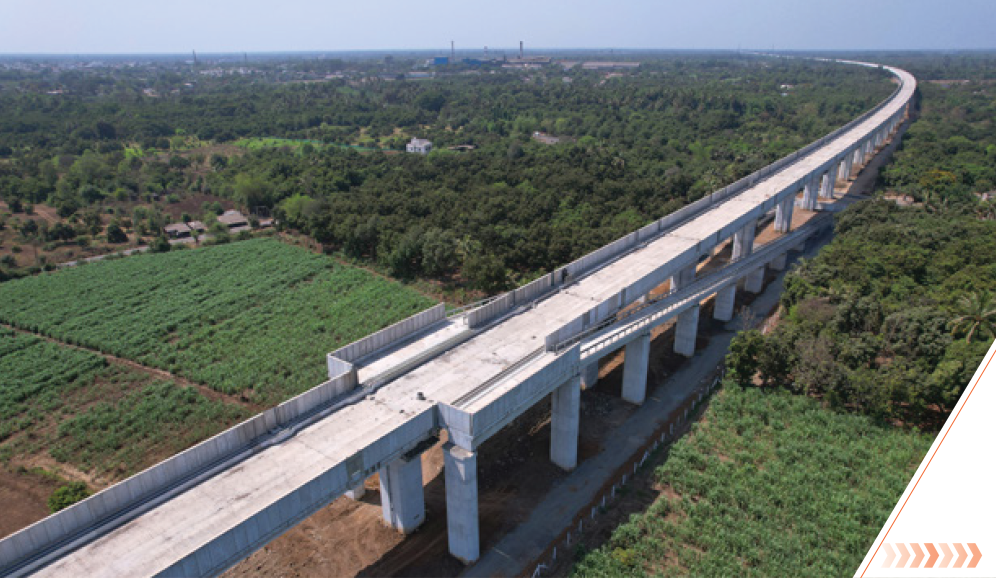
All are complex elements too. The noise barrier segment is a 2.4 m high, complex 3D eccentric ‘C’ shaped element with top and bottom projections of 250 mm and 420 mm, respectively, and an 80 mm thick face wall. The bottom projection tapers at the side edges, and the segment sides feature male and female interlocking shear keys with a 6 mm chamfer all around. The cable duct segment has an inner corbel to support the cover slab making demoulding tricky.
After much brainstorming, the team boldly decided to manufacture more than 60% of these elements inhouse by developing a robust manufacturing hub with minimal human interface, designed to achieve 1.5 cycles per day. Measuring 150 m x 75 m with 3 bays of 25 m each, the hub is equipped with several features. An automated concrete supply system transports concrete from the two batching plants in a shuttle and pours it precisely into the Comcaster and Framecaster. Overhead cranes, an automated runoff truck, a chiller plant, boiler house, GAS bank, stacking yard, and an adequate drainage system completes the set up.
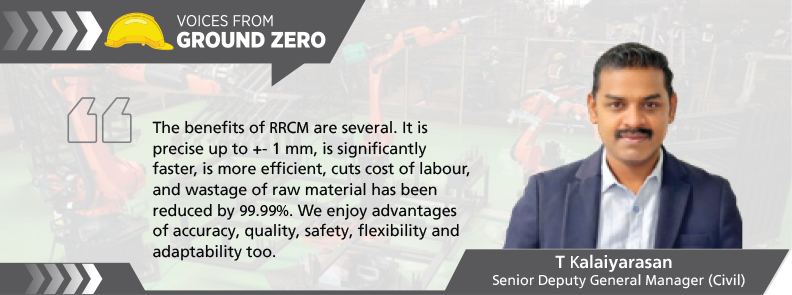
To meet the completion targets, the factory maintains a daily production rate exceeding 500 noise barriers and 400 cable ducts for which robust data was essential to identify bottlenecks and understand dependencies between activities to improve production efficiency. Since traditional methods of recording data were not feasible in terms of effort, data accuracy, and continuity given the scale of production, a more advanced data collection and analysis system – Computer Vision – was developed. This AI-based solution has enhanced monitoring, analysis and productivity and importantly, does not require any manual keying in of data. Based on the camera input, the engine analyses and provides actionable data for improvement.
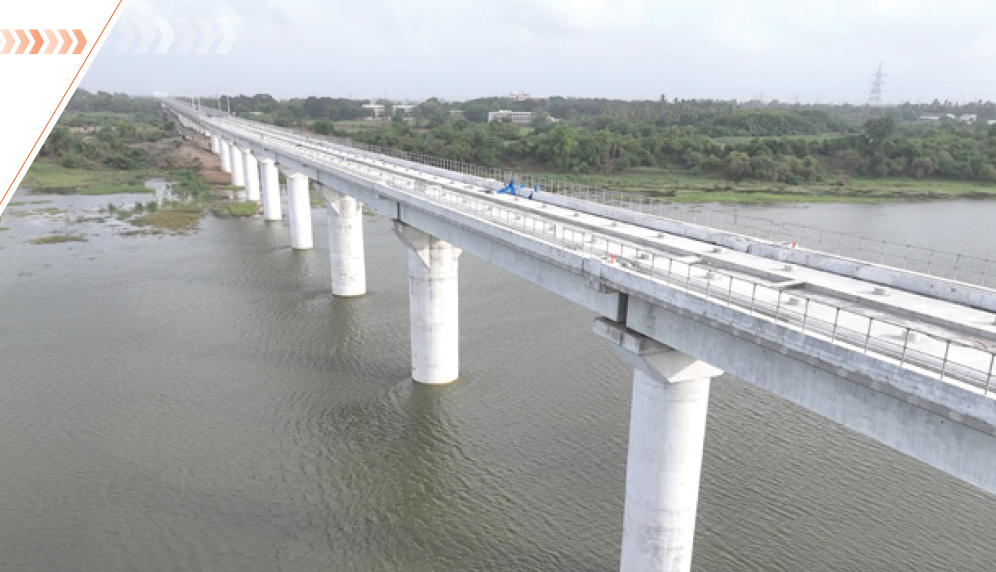
Completed river bridge viaduct across the Purna River
For Mangal, the results have been more than encouraging. “We precast about 30,000 elements per month with much less manpower, the gas-powered vapor generators reduce fuel costs and carbon emissions and what’s more, this hub can
easily be shifted to other locations.”
Seismic stoppers involve fixed & moveable components apart from a concrete filled tube. The demand for 38,312 units for the 237-km stretch of Package C4 and another 100 km of Packages C6 and C5 meant a monthly asking rate of 2,000 units. Only two local vendors possessed the technical knowhow but lacked the production capacity to meet both the numbers and the stringent tolerances dictated by Japanese standards. Since dependence on foreign suppliers was considered risky, the team looked inwards for solutions.
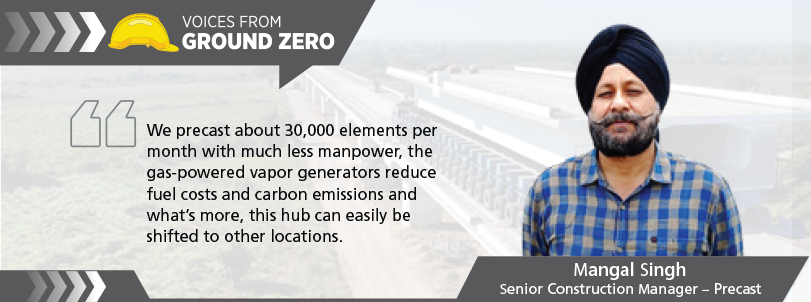
The L&T Piping Centre (LTPC) at Hazira was chosen for their specialized competency in stringent fabrication works and strategic location, while Hevea Rubber Technologies Pvt Ltd was identified to develop the rubber sleeves using imported chloroprene rubber, bound by an exclusive agreement not to supply similar rubber sleeves to other agencies. Although LTPC lacked the expertise to integrate steel & rubber, the team supported product development by adopting a flow line concept for manufacturing.
“We have developing inhouse production capabilities that will stand us in good stead in the long run,” notes a satisfied Vinod, “and, at the same time, we have eliminated our dependence on foreign suppliers, substantially reducing costs and enhancing technical competency in the process.” This too can be successfully extended to other MAHSR packages.
Ensuring a well-appointed deck
The configuration of essential deck furniture elements across the viaduct span is crucial to ensure the seamless movement of the bullet trains that include adjusting concrete, cable ducts, noise barriers, cover slabs, metal fences, and pull pits, all requiring to be precisely installed within a stringent timeline. Convinced that conventional erection methods would leave them high and dry, the team has implemented an inhouse developed Deck Furnishing Solution (DFS) that features several pioneering advancements:
- Noise Barrier & Cable Duct Erector: This indigenous designed ‘Pi’ shape erector, capable of lifting loads of up to 10 MT, mounted on rails and remote controlled via radio, allows the passage of girder transporters during erection, ensuring uninterrupted FSG erection. The erector can withstand wind speeds of up to 44m/s and operates at a hoisting speed of 7.0 MPM.
- Erector for Non-Standard & Residual Items: Designed for later-stage erection of non-standard dimension elements, this erector runs above the deck slab after track bed concrete is completed, ensuring flexibility and adaptability.
- Traveling Form & Portable Form for Adjusting Concrete: To expedite the casting process of adjusting concrete, a traveling formwork system mounted on rail tracks ensures secure support of the outer shutter and efficient casting along the viaduct deck slab.
- Adjustable Form for Cable Pull Pit: An adjustable formwork system for pull pits, designed to be lightweight and manually handled, ensures precise casting.
- Traveling Platform for Sealant Application: A portable platform system for sealant applications, designed to accommodate up to five applicators, for efficient and swift application across the project site.
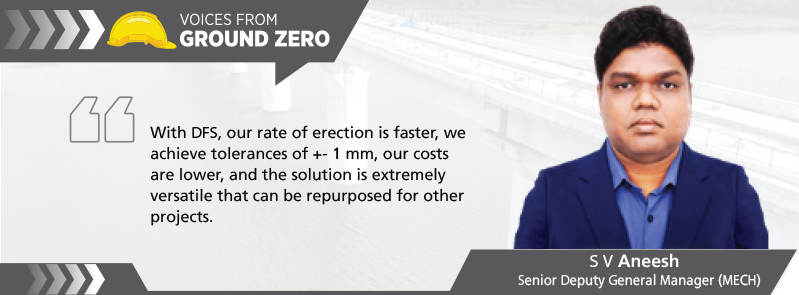
Apart from operation efficiency, DFS has improved quality, safety and sustainability much to Senior Deputy General Manager (MECH), S V Aneesh’s satisfaction. “Our rate of erection is faster, we achieve tolerances of +- 1 mm, our costs are lower, and the solution is extremely versatile that can be repurposed for other projects.”
Even as this showcase project speeds to conclusion and the nation waits with bated breath to take its first ride on trains travelling at 300+ km per hour, the MAHSR C4 team is constantly seeking ways to innovate to deliver even faster, meeting the quality and safety mandates, riding the tech wave.